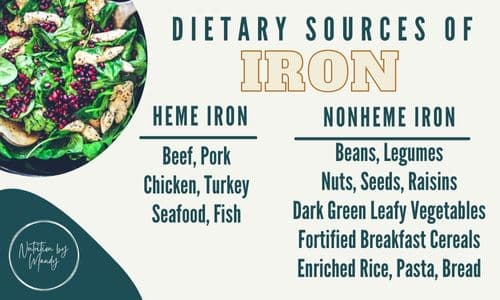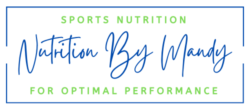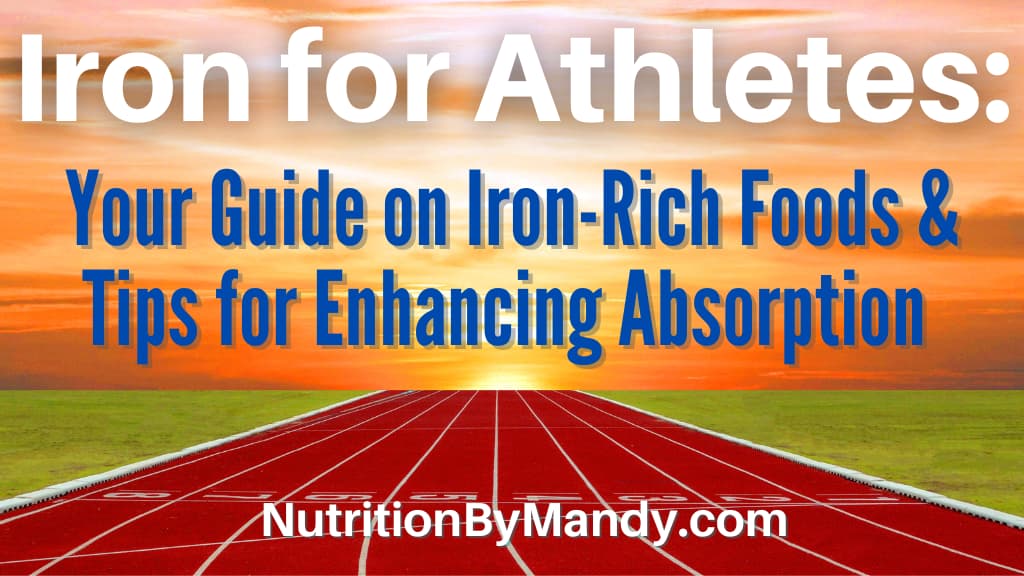Iron for Athletes: Your Guide on Iron-Rich Foods & Tips for Enhancing Absorption
When it comes to sports performance, iron is often a nutrient that gets overlooked until a deficiency occurs. Iron has many important functions in the body and is important for athletes.
Role of Iron in the Body
Iron is a mineral with many important roles in the body. Iron is necessary to form hemoglobin, which is a component of red blood cells. Hemoglobin helps transport oxygen throughout the body and to working muscles during exercise.
Iron is also important for athletes to maintain a healthy immune system, form connective tissue, and for cognitive function.
Iron Needs of Athletes
How much iron an athlete needs depends on both the athlete’s age and sex. The Recommended Dietary Allowances1 (RDAs) for iron are listed below.
Boys – Iron Recommended Dietary Allowance
- Boys, Age 9-13 years: 8 mg/day of iron
- Boys, Age 14-18 years: 11 mg/day of iron
- Boys, Age 19+ years: 8 mg/day of iron
Girls – Iron Recommended Dietary Allowance
- Girls, Age 9-13 years: 8 mg/day of iron
- Girls, Age 14-18 years: 15 mg/day of iron
- Girls, Age 19-50 years: 18 mg/day of iron
- Girls, Age 50+ years: 8 mg/day of iron
The higher iron needs of females prior to menopause help to replace the iron lost through the menstrual cycle. The RDA for pregnant females further increases to 27 mg of iron/day. This to support the increased blood volume that occurs during pregnancy as well as the iron needs of the developing baby.
Iron-Deficiency in Athletes
When an athlete’s iron stores become low, iron-deficiency anemia can result. Without the needed iron to transport oxygen throughout the body, an athlete may experience fatigue, weakness, dizziness, headaches, impaired immunity, and decreased performance.
Sources of Iron in the Diet
With the essential roles iron serves in the body, it is important for athletes to include iron-rich foods as a regular part of their performance diet. Iron in the diet comes from both animal (heme) and plant (nonheme) sources.
Sources of Heme Iron for Athletes
Heme iron is more readily absorbed by the body than nonheme iron. Heme iron comes from animal sources, such as:
- Beef
- Chicken
- Turkey
- Seafood
- Pork
Sources of Nonheme Iron for Athletes
Nonheme iron comes from plant-based sources as well as foods that are fortified with iron. The body does not absorb nonheme iron as well as it does heme iron.
Sources of non-heme iron include:
- Beans and Legumes
- Nuts, seeds, and raisins
- Dark green leafy vegetables
- Fortified breakfast cereals
- Enriched rice, pasta, and bread

Tips for Helping Athletes Increase Iron Absorption
There are ways to help increase the body’s absorption of non-heme iron.
Vitamin C and Iron Absorption
Consuming foods and beverages that contain Vitamin C with your plant-based sources of iron is a way to enhance the absorption of non-heme iron.
Foods containing Vitamin C include:
- Citrus Fruits and Juices
- Strawberries, Blueberries, Raspberries
- Cantaloupe, Kiwi, Mangos, Papaya
- Tomatoes and Tomato Juice
- Broccoli, Brussel Sprouts, and Bell Peppers
Examples for combining Vitamin C with iron containing foods include: adding tomatoes to your pasta, stirring fresh berries into breakfast cereal, and topping your salad with colorful bell peppers.
Pairing Heme and Nonheme Iron
Consuming sources of heme and nonheme iron together also helps enhance the absorption of non-heme iron. Eating meals that contain meat, seafood, chicken or turkey along with plant-based sources of iron will increase the body’s absorption of the nonheme iron.
For example, eating chicken with rice and beans will increase the body’s absorption of the iron from the rice and beans.
Cook in Cast-Iron Skillets
If you enjoy cooking food at home, the use of cast-iron skillets can increase the iron content of the foods you prepare. This is another easy way to boost the iron content of your meals.

Factors that Decrease Iron Absorption
When consuming iron-rich foods, it is also important to be aware of nutrients that can hinder the body’s absorption of iron.
Polyphenols
Polyphenols are antioxidants found in many plant-based foods and can inhibit the absorption of nonheme iron by the body2. Common foods and beverages containing polyphenols include:
- Coffee
- Tea
- Wine
- Cereals
- Fruits
- Vegetables
- Legumes
Although polyphenols may reduce iron absorption, they do provide many other health benefits. To support iron absorption, athletes should avoid consuming foods that are high in polyphenols at the same time as iron-rich foods.
If you enjoy tea and coffee, drink these beverages between meals rather than with a meal containing iron-rich foods.
Phytates and Oxalates
Phytates are naturally occurring antioxidants found in beans, grains, nuts, and seeds. Oxalates are compounds found in plant-based foods such as: tea, kale, spinach, beans, nuts, and chocolate. Similar to polyphenols, phytates and oxalates can interfere with nonheme iron absorption by the body.
Consuming foods and beverages that contain Vitamin C along with foods containing polyphenols, phytates, or oxalates can help counteract the effects these compounds have on iron absorption2.
Calcium
Calcium reduces absorption of both heme and nonheme iron by the body2. The mineral calcium is found in dairy products as well as in many calcium-fortified juices, breakfast cereals and bars. Consuming dairy products and other food and beverages containing calcium separate from iron-rich foods can help reduce this concern. If you take a calcium supplement, you also will want to take this at a different time.
Iron Needs of Vegetarian and Vegan Athletes
Iron may be a nutrient of concern for athletes following a vegetarian or vegan diet. As discussed above, nonheme iron from plant-based foods is not absorbed by the body as well as heme iron is. In addition, polyphenol, phytates, and oxalates found in many plant foods inhibit the absorption of iron.
Athletes following a vegetarian or vegan diet should regularly monitor their iron status3. This is particularly important for pre-menopausal females who are losing iron through their menstrual cycle.
Vegetarian and vegan athletes should also follow the strategies discussed previously for enhancing the absorption of nonheme iron.
Should I Take an Iron Supplement?
Prior to taking a high-dose iron supplement, athletes should have their iron status checked to see if a deficiency exists. Consuming excess iron from supplements can interfere with the absorption of zinc. High-dose iron supplements are also frequently associated with gastrointestinal complaints such as constipation, nausea, and diarrhea1.
Excess iron intake is also a concern for athletes at risk for hemochromatosis. Hereditary hemochromatosis is a condition in which iron builds-up in the body’s organs and can cause severe health concerns. Athletes taking iron supplements should regularly have their iron status monitored to prevent an iron overload from occurring.
Importance of Iron for Athletes
Bottom line – iron is an important nutrient for sports performance. Regularly consuming both heme and non-heme iron sources in the diet can help prevent a deficiency from occurring.
If you have concerns about your current iron intake, consider visiting with a Registered Dietitian who can develop an individualized meal plan to meet your sports nutrition needs. For additional information on sports nutrition, check-out my recent blog: Your Guide to Game Day Nutrition.
Submit your e-mail address below to sign-up for the Nutrition By Mandy e-mail list.
References
- Otten, J. J., Jennifer Pitzi Hellwig, & Meyers, L. (2014). Dietary Reference Intakes The Essential Guide to Nutrient Requirements. Washington National Academies Press [Ann Arbor, Michigan] [Proquest).
- Ems T, St Lucia K, Huecker MR. Biochemistry, Iron Absorption. [Updated 2022 Apr 21]. In: StatPearls [Internet]. Treasure Island (FL): StatPearls Publishing; 2022 Jan-. Available from: https://www.ncbi.nlm.nih.gov/books/NBK448204/
- Thomas, D. T., Erdman, K. A., & Burke, L. M. (2016). American College of Sports Medicine Joint Position Statement. Nutrition and Athletic Performance. Medicine and science in sports and exercise, 48(3), 543–568. https://doi.org/10.1249/MSS.0000000000000852

